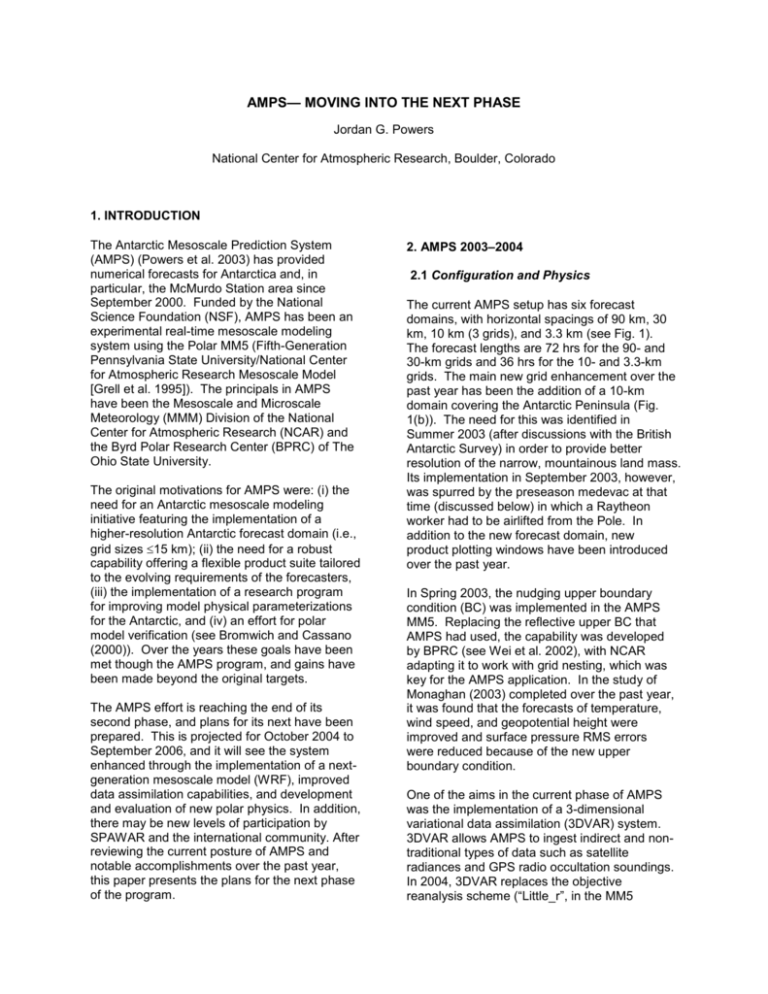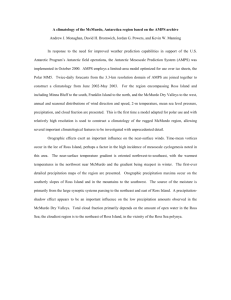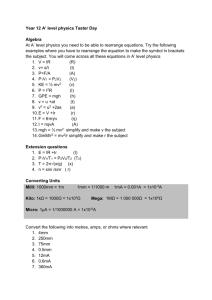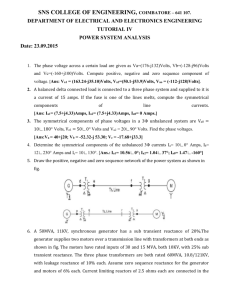Abstract - Antarctic Projects
advertisement

AMPS— MOVING INTO THE NEXT PHASE Jordan G. Powers National Center for Atmospheric Research, Boulder, Colorado 1. INTRODUCTION The Antarctic Mesoscale Prediction System (AMPS) (Powers et al. 2003) has provided numerical forecasts for Antarctica and, in particular, the McMurdo Station area since September 2000. Funded by the National Science Foundation (NSF), AMPS has been an experimental real-time mesoscale modeling system using the Polar MM5 (Fifth-Generation Pennsylvania State University/National Center for Atmospheric Research Mesoscale Model [Grell et al. 1995]). The principals in AMPS have been the Mesoscale and Microscale Meteorology (MMM) Division of the National Center for Atmospheric Research (NCAR) and the Byrd Polar Research Center (BPRC) of The Ohio State University. The original motivations for AMPS were: (i) the need for an Antarctic mesoscale modeling initiative featuring the implementation of a higher-resolution Antarctic forecast domain (i.e., grid sizes 15 km); (ii) the need for a robust capability offering a flexible product suite tailored to the evolving requirements of the forecasters, (iii) the implementation of a research program for improving model physical parameterizations for the Antarctic, and (iv) an effort for polar model verification (see Bromwich and Cassano (2000)). Over the years these goals have been met though the AMPS program, and gains have been made beyond the original targets. The AMPS effort is reaching the end of its second phase, and plans for its next have been prepared. This is projected for October 2004 to September 2006, and it will see the system enhanced through the implementation of a nextgeneration mesoscale model (WRF), improved data assimilation capabilities, and development and evaluation of new polar physics. In addition, there may be new levels of participation by SPAWAR and the international community. After reviewing the current posture of AMPS and notable accomplishments over the past year, this paper presents the plans for the next phase of the program. 2. AMPS 2003–2004 2.1 Configuration and Physics The current AMPS setup has six forecast domains, with horizontal spacings of 90 km, 30 km, 10 km (3 grids), and 3.3 km (see Fig. 1). The forecast lengths are 72 hrs for the 90- and 30-km grids and 36 hrs for the 10- and 3.3-km grids. The main new grid enhancement over the past year has been the addition of a 10-km domain covering the Antarctic Peninsula (Fig. 1(b)). The need for this was identified in Summer 2003 (after discussions with the British Antarctic Survey) in order to provide better resolution of the narrow, mountainous land mass. Its implementation in September 2003, however, was spurred by the preseason medevac at that time (discussed below) in which a Raytheon worker had to be airlifted from the Pole. In addition to the new forecast domain, new product plotting windows have been introduced over the past year. In Spring 2003, the nudging upper boundary condition (BC) was implemented in the AMPS MM5. Replacing the reflective upper BC that AMPS had used, the capability was developed by BPRC (see Wei et al. 2002), with NCAR adapting it to work with grid nesting, which was key for the AMPS application. In the study of Monaghan (2003) completed over the past year, it was found that the forecasts of temperature, wind speed, and geopotential height were improved and surface pressure RMS errors were reduced because of the new upper boundary condition. One of the aims in the current phase of AMPS was the implementation of a 3-dimensional variational data assimilation (3DVAR) system. 3DVAR allows AMPS to ingest indirect and nontraditional types of data such as satellite radiances and GPS radio occultation soundings. In 2004, 3DVAR replaces the objective reanalysis scheme (“Little_r”, in the MM5 system) that had been used as the primary data assimilation package in AMPS. 3DVAR’s performance in AMPS has been reviewed over the past year and has been found to be satisfactory. With the current observation stream, while limited improvements are found from 3DVAR (as compared to Little-r), with a future increase in observations from satellites, the improvements are expected to grow. 2.2 Applications As in 2001 and 2002 with the Shemenski and Magdalena Oldendorff rescue episodes, AMPS was positioned to support emergency Antarctic missions in 2003 and 2004. In September 2003, an ill Raytheon worker at the South Pole had to be removed for medical treatment. As this was before the regular season flights to the Pole had begun, a special mission was necessary. AMPS was used in the flight forecasting of the dispatch of a Twin Otter from Rothera to the Pole to pull out the ailing employee. To support the operation, the 10-km Antarctic peninsula grid was rushed to completion so that higherresolution forecasts of the region surrounding Rothera would be available. In fact, this is the highest-resolution real-time grid over this area of any global or regional NWP system. Ultimately, the rescue was successful, with the Twin Otter safely making the Rothera–Pole–Rothera trip to carry out the employee. April 2004 saw a second off-season rescue. Three employees at McMurdo were diagnosed with various conditions calling for attention unavailable at the McMurdo hospital. In this effort, a C-141 was sent from California to Christchurch to be used to retrieve the workers, and AMPS was used in the flight forecasting of the 141’s trip to McMurdo. After landing at Pegasus runway in temperatures of 25C, the plane pulled the three from McMurdo on April 10 and returned safely to Christchurch. The AMPS archive was exercised in ‘03–’04 to develop climatological information for selected locations on the ice. This was motivated by an inquiry from Raytheon about conditions at possible sites of operation. BPRC used the archive to determine the model-indicated range of conditions at the locations. In December, NCAR visited the SPAWAR operations at McMurdo and Christchurch. This allowed a first-hand look at the forecasters’ environment and work, and provided an excellent opportunity to witness the demands on all involved in monitoring, forecasting, and working in the weather. Extensive discussions were held with the SPAWAR forecasters, as well as air traffic control and support staff. Voluminous feedback was received and the AMPS system and its functioning were explained. The AMPS team implemented a wave of improvements to the system based on the feedback, further tailoring it to the needs of the front-line forecasters. The modifications included corrections to products for the South Pole, the addition of a Ross-Beardmore window for this heavily-trafficked sector, and enhancements to the AMPS animator. 3. THE NEXT PHASE The next two years will be critical for AMPS. Most importantly, it will switch to a new mesocale model, the Weather Research and Forecasting (WRF) model. WRF is a nextgeneration mesoscale NWP model designed for both research and operations (see www.wrfmodel.org), and it will become operational at various forecasting centers (e.g., NCEP) in 2004 and 2005. WRF will be replacing the MM5 in the research community as well. The MM5 code itself will be frozen in 2004. The WRF activities in the next phase will cover: (1) modeling system enhancement, (2) data assimilation system studies and improvements, (3) polar physics development, and (4) forecast verification/evaluation. The task areas are: • Implementation of WRF; • Data assimilation system experimentation and ingest of new data types; • Enhancement of AMPS forecast domains; • Development and implementation of new polar physics and evaluation of the physics and the new model; and • Development of a climatological database employing the AMPS archive. It is vital for AMPS to be positioned to exploit the latest advances in modeling and model physics. Specifically, AMPS must respond to the fact that the MM5 system development by NCAR and the research community is transitioning to WRF. Thus, a major component of the next AMPS phase will be the implementation of WRF as the system’s mesoscale model. In addition, a planned effort at BPRC to put the polar physics into WRF will be leveraged. This will not only benefit the AMPS users, but also the polar research community. A heavily-used AMPS forecast domain is the 30km grid that covers the whole of Antarctica. While it can resolve mesoscale features, enhanced resolution on the continental scale is needed. Thus, a significant improvement contemplated would be to increase the resolution of this domain to 20 km or greater. Furthermore, as the resolution is increased on the continental scale, the increase would carry through to the nests covering the mesoscale regions of most interest, such as Ross Island and the Antarctic Peninsula. The decreased grid spacings, however, would require significantly increased computing power. Data assimilation has been an area of ongoing experimentation and development for the AMPS system. In the next phase, 3DVAR will be used in exploring forecast cycling and ingesting newer types of satellite data. Cycling may allow for reduced time for spin-up of mesoscale details in the forecasts, as high-resolution AMPS output would become the first guess of the following initialization. With respect to satellite observations, an example is MODIS winds. These data have been shown to be beneficial to forecasts when ingested by 4DVAR in real-time, polar-area runs of the ECMWF model (Bormann and Thepaut 2004). MODIS winds are currently being ingested in AMPS, and an evaluation of their impact is planned. An anticipated satellite data source, COSMIC (Constellation Observing System for Meteorology, Ionosphere, and Climate), is expected to have real-time GPS radio occultations (serving as satellite-derived soundings) available in 2006. These will cover the polar regions with hundreds of soundings per day. An alternative to 3DVAR being developed at NCAR (among other institutions) is the Ensemble Kalman Filter (EnKF) technique. Practical advantages of EnKF include the implicit cycling of synoptically-dependent background error (BE) covariances, and reduced development costs relative to 4DVAR. For EnKF exploration in AMPS, an initial task would be to define BE covariances based on ensemble statistics. This method could be used to compute climatological covariances producing forecasts superior to those using statistics calculated via the older, “NMC method” currently used in AMPS. Furthermore, the EnKF approach would be applied to develop synoptically-dependent BE statistics to yield better initializations. Finally, the EnKF approach would be compared with 3DVAR using ensemble-based statistics. Comparison between WRF 3DVAR and EnKF techniques in a polar environment would supplement existing mid-latitude/mesoscale EnKF research and would shed light on the assimilation strategy most suitable for AMPS . New polar physics development will include an in-depth examination of cloud–radiation interaction, which continues to be the critical issue in high-latitude atmospheric prediction. The goal is improved representation of the downwelling longwave radiation for the polar atmosphere. Physics development will also include the study and implementation of an improved formulation for the horizontal pressure gradient force. This is critical for near-surface wind prediction in areas of complex terrain, such as around the Transantarctic Mtns. and McMurdo/Ross Is. Lastly, a blowing snow parameterization will be implemented, as this phenomenon is a key constraint on aircraft landings and take-offs. The AMPS verification program will continue. Examined will be model performance in scenarios of importance to the forecasting and research communities, specifically: (a) verifying key weather phenomena for the McMurdo region (e.g., fog), and (b) evaluating the new cloudradiation interaction, blowing snow, and pressure-gradient force physics. These examinations would yield a better understanding of the system's ability to forecast crucial weather conditions and would provide assessments of the new physics. There will likely be an effort to develop the climatological database for use by the broader community. This would involve building the capability to extract monthly mean gridded data and time series for various locations on the ice from the AMPS archive via a web-based interface. This has operational and scientific applications, as evidenced by the increasing number of requests for archived AMPS data. For example, Raytheon has already requested model database information about potential sites for flight or surface activity. AMPS is positioned to support the preliminary activities of the planned Ross Island Meteorology Experiment (RIME) over the next two years. During this period, the archive can be used both for case studies and for model climatologies of potential camps. During the campaign itself, AMPS can provide real-time support for science and logistics. 4. SUMMARY The AMPS effort will be entering a new phase, while over the past year the system has continued to grow. Most notably, a 10-km forecast grid was added to better capture conditions over the Antarctic Peninsula, and 3DVAR became the primary data assimilation system. AMPS went through two significant rounds of modifications to meet forecaster needs and recommendations. The first was following the AMPS 2003 Users’ Workshop, while the second was after meetings with the forecasters at McMurdo. In addition, AMPS has responded to requests from the international community for specialized products and services. The next phase of AMPS will bring it into the age of WRF. This next-generation mesoscale modeling capability will position the AMPS effort with a system that will improve with the input to WRF from the research community. While the WRF 3DVAR capability will serve for data assimilation, other techniques will be explored to uncover possible improvements to this key component. As in the past, the AMPS effort will be responsive to the requests of the user community and will tailor a system to meet its needs. Ultimately, some international contributions may be contemplated for the maintenance and enhancement of the system. Through the next phase, AMPS will continue to provide high-resolution mesoscale guidance to Antarctic forecasters and to support field campaigns, flight and scientific operations, and emergency efforts. (a) (c) (b) Fig. 1: AMPS domains. (a) 90-km grid. (b) 30-km grid (outer frame) and nests: 10-km McMurdo/Ross grid, 10-km South Pole grid, 10-km Antarctic Peninsula grid, and 3.3-km Ross Is. grid. (c) Close-up of 10-km McMurdo/Ross grid and 3.3-km Ross Island grid. Acknowledgments NCAR and OSU thank NSF for its support of AMPS and SPAWAR for its contributions to the AMPS program. References Bormann, N., and J.-N. Thepaut, 2004: Impact of MODIS polar winds in ECMWF’s 4DVAR data assimilation system. Mon. Wea. Rev., 132, 929–940. Bromwich, D.H., and J.J. Cassano, 2000: Recommendations to the National Science Foundation from the Antarctic Weather Forecasting Workshop. BPRC Misc. Series M420, 48 pp. [Available from Byrd Polar Research Center, The Ohio State University, 1090 Carmack Rd., Columbus, OH, 43210-1002] Grell, G.A., J. Dudhia, and D.R. Stauffer, 1995: A Description of the Fifth-Generation Penn State/NCAR Mesoscale Model (MM5), NCAR Tech. Note TN-398 + STR, 122 pp. [Available from UCAR Communications, P.O. Box 3000, Boulder, CO 80307] Monaghan, A.J., 2003: Real-time forecasting for the Antarctic: An evaluation of the Antarctic Mesoscale Prediction System (AMPS). M.S. Thesis, Dept. of Geography, The Ohio State University, 171 pp. Powers, J.G., A.J. Monaghan, A.M. Cayette, D.H. Bromwich, Y.-H. Kuo, and K.W. Manning, 2003: Real-Time mesoscale modeling over Antarctica: The Antarctic Mesoscale Prediction System (AMPS). Bull Amer. Meteor. Soc., 84, 1533–1546. Wei, H., D.H. Bromwich, L.-S. Bai, Y.-H. Kuo, and T. Wee, 2002: A case study of upper boundary condition in MM5 over Antarctica. 12th PSU/NCAR Mesoscale Model Users’ Workshop, Boulder, Natl. Center for Atmos. Res., 31–35.








